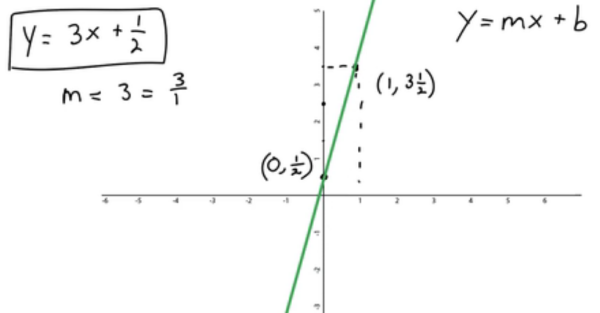Introduction
In this lesson, you will learn how to graph a line using the slope and y-intercept.
This video illustrates the lesson material below. Watching the video is optional.
Graphing a Line Using the Slope and Y-Intercept
The slope-intercept form of a line is
Example 1
Graph the following line that is given in y-intercept form:
You could graph this by substituting in values for x and solving for y, but with the slope-intercept form of a line, one of the points is already given (b, or the y-intercept). The y-intercept is at

Figure 1
You only need two points in order to determine a straight line. Use the slope (m), or
In other words, for every three units you go up, you take one step to the right. To plot the second point, follow these steps:
- Start at the point that you already have, which is known as the y-intercept,
- Go three units up and one unit to the right.
- You get to
Now that you have two points, you can draw a line between them, and that will be the graph of this line.

Figure 2
Example 2
Graph the following line that is given in y-intercept form:
Once again, you know the first point is at

Figure 3
Now you just need to find another point using the slope (m).
A negative slope goes from the top left down toward the bottom right. You can easily find the second point using this slope. It is really important to remember that the following slopes below are the same.
- You could either go down three and to the right four, which gives this point:
- Or, you could go up three and then to the left four and this point:
Either way, one of the directions needs to be in the negative direction, and the other needs to be in the positive direction.

Figure 4
Figure 4 shows the line of
Things to Remember
- You need a minimum of two points to find the line of an equation.
- Steps for graphing an equation using the slope and y-intercept:
- Step 1: Plot the y-intercept from the slope-intercept form.
- The y-intercept = b of the equation
- The point will be
- The y-intercept = b of the equation
- Step 2: Use the slope (m) or
- Make single steps, using the rise and run from the y-intercept.
- Plot the second point.
- Step 3: Connect those two points with your line.
- Step 1: Plot the y-intercept from the slope-intercept form.
Practice Problems
- Plot the line
- Plot the line
- Plot the line
- Plot the line
- Plot the line
- Plot the line